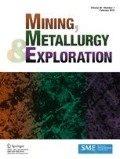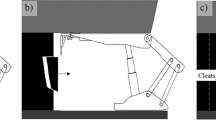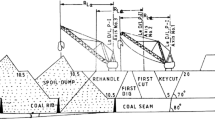Abstract
Coal is still a part of energy generation worldwide and has a significant role in the sustainable development of countries. The amount of shallow coal deposits is getting scarce, making efficient underground mining operations crucial for both local and global economies. In underground mining operations, longwall mining is a commonly utilized method to extract deep coal deposits. One of the leading engineering goals in longwall mining is increasing the efficiency of the system by investigating the effects of operational factors on equipment. This paper investigates the shearer performance for a longwall top coal caving operation by discrete event simulation that includes modeling the double-drum shearer, belt conveyors, stage loader, and armored face conveyors (AFC) to evaluate system performance by considering the amount of daily coal production of the shearer. As a result, the most influential factor on mine production is determined and a data-based framework is developed. This study suggests a framework for data collection, data analysis, and the interpretation of the operational data to evaluate the primary production unit’s performance. The models developed for the face coal extraction operations in a longwall top coal caving (LTCC) mine have a bi-directional cutting system and can be implemented in other operations readily.











Similar content being viewed by others
References
World Energy Council (2016) World Energy Resources. https://www.worldenergy.org/wp-content/uploads/2016/10/World-Energy-Resources-Full-report-2016.10.03.pdf. Accessed 30 August 2020
Ghosh N, Agrawal H, Singh SK, Banerjee G (2020) Optimum chain pillar design at the deepest multi-seam longwall workings in India. Min Metall Explor 37:651–664. https://doi.org/10.1007/s42461-019-00138-z
Kahraman MM, Rogers WP, Dessureault S (2020) Bottleneck identification and ranking model for mine operations. Prod Plan Control 31:1178–1194. https://doi.org/10.1080/09537287.2019.1701231
Pendharkar PC, Rodger JA (2000) Nonlinear programming and genetic search application for production scheduling in coal mines. Ann Oper Res 95:251–267. https://doi.org/10.1023/A:1018958209290
Edwards DJ, Malekzadeh H, Yisa SB (2001) A linear programming decision tool for selecting the optimum excavator. Struct Surv 19:113–120. https://doi.org/10.1108/EUM0000000005628
Kumral M (2004) Genetic algorithms for optimization of a mine system under uncertainty. Prod Plan Control 15:34–41. https://doi.org/10.1080/09537280310001654844
Faradonbeh RS, Monjezi M, Armaghani DJ (2016) Genetic programing and non-linear multiple regression techniques to predict backbreak in blasting operation. Engineering with Computers 32:123–133. https://doi.org/10.1007/s00366-015-0404-3
Yong W, Zhou J, Armaghani DJ, Tahir MM, Tarinejad R, Pham BT, Van Huynh V (2020)A new hybrid simulated annealing-based genetic programming technique to predict the ultimate bearing capacity of piles. Engineering with Computers.https://doi.org/10.1007/s00366-019-00932-9
Wang H, Tenorio V, Li G, Hou J, Hu N (2020) Optimization of trackless equipment scheduling in underground mines using genetic algorithms. Min Metall Explor 37:1531–1544. https://doi.org/10.1007/s42461-020-00285-8
Asad MWA (2011) A heuristic approach to long-range production planning of cement quarry operations. Prod Plan Control 22:353–364. https://doi.org/10.1080/09537287.2010.484819
Koushavand B, Askari-Nasab H, Deutsch CV (2014) A linear programming model for long-term mine planning in the presence of grade uncertainty and a stockpile. Int J Min Sci Technol 24:451–459. https://doi.org/10.1016/j.ijmst.2014.05.006
Ben-Awuah E, Richter O, Elkington T, Pourrahimian Y (2016) Strategic mining options optimization: open pit mining, underground mining or both. Int J Min Sci Technol 26:1065–1071. https://doi.org/10.1016/j.ijmst.2016.09.015
Zhen L, Wang B, Li M, Wang W, Huang L (2019) Inspection routing problem for coal mine safety personnel in underground mines. Comput Ind Eng 130:526–536. https://doi.org/10.1016/j.cie.2019.03.003
Banks J, Carson JS, Nelson BL, Nicol DM (2010) Discrete-event system simulation, 5th edn. Pearson Education-Prentice Hall, Upper Saddle River
Salama A, Greberg J, Schunnesson H (2014) The use of discrete event simulation for underground haulage mining equipment selection. Int J Min Miner Eng 5:256–271. https://doi.org/10.1504/IJMME.2014.064486
Sturgul JR (2015) Discrete simulation and animation for mining engineers. CRC Press, Boca Raton
Dindarloo SR, Osanloo M, Frimpong S (2015) A stochastic simulation framework for truck and shovel selection and sizing in open pit mines. J South Afr Inst Min Metall 115:209–219
Meng C, Nageshwaraniyer SS, Maghsoudi A, Son YJ, Dessureault S (2013) Data-driven modeling and simulation framework for material handling systems in coal mines. Comput Ind Eng 64:766–779. https://doi.org/10.1016/j.cie.2012.12.017
Soofastaei A, Aminossadati SM, Kizil MS, Knights P (2016) A discrete-event model to simulate the effect of truck bunching due to payload variance on cycle time, hauled mine materials and fuel consumption. Int J Min Sci Technol 26:745–752. https://doi.org/10.1016/j.ijmst.2016.05.047
Upadhyay SP, Askari-Nasab H (2018) Simulation and optimization approach for uncertainty-based short-term planning in open pit mines. Int J Min Sci Technol 28:153–166. https://doi.org/10.1016/j.ijmst.2017.12.003
Que S, Awuah-Offei K, Frimpong S (2016) Optimising design parameters of continuous mining transport systems using discrete event simulation. Int J Min Reclam Environ 30:217–230. https://doi.org/10.1080/17480930.2015.1037056
Ozdemir B, Kumral M (2018) Appraising production targets through agent-based Petri net simulation of material handling systems in open pit mines. Simul Model Pract Theory 87:138–154. https://doi.org/10.1016/j.simpat.2018.06.008
Salama A, Nehring M, Greberg J (2015) Evaluation of the impact of commodity price change on mine plan of underground mining. Int J Min Sci Technol 25:375–382. https://doi.org/10.1016/j.ijmst.2015.03.008
Greberg J, Salama A, Gustafson A, Skawina B (2016) Alternative process flow for underground mining operations: analysis of conceptual transport methods using discrete event simulation. Minerals 6:65. https://doi.org/10.3390/min6030065
Ozdemir B, Kumral M (2019) Simulation-based optimization of truck-shovel material handling systems in multi-pit surface mines. Simul Model Pract Theory 95:36–48. https://doi.org/10.1016/j.simpat.2019.04.006
Bernardi L, Kumral M, Renaud M (2020) Comparison of fixed and mobile in-pit crushing and conveying and truck-shovel systems used in mineral industries through discrete-event simulation. Simul Model Pract Theory 103:102100. https://doi.org/10.1016/j.simpat.2020.102100
Hong SY, Bal A, Badurdeen F, Agioutantis Z, Hicks S (2020) Evaluation of bunker size for continuous/discrete flow systems by applying discrete event simulation: a case study in mining. Simul Model Pract Theory 105:102155. https://doi.org/10.1016/j.simpat.2020.102155
Tarshizi EK (2014) Multiple discrete-event simulation and animation models to assist modern mining operations. Doctoral Thesis in Geoengineering, University of Nevada
Hustrulid WA, Bullock RL (2001) Underground mining methods: engineering fundamentals and international case studies. SME, Littleton
Mozafari N, Tikhomirov D, Sumer Ö, Özkaymak Ç, Uzel B, Yeşilyurt S, Ivy-Ochs S, Vockenhuber C, Sözbilir H, Akçar N (2019) Dating of active normal fault scarps in the Büyük Menderes Graben (western Anatolia) and its implications for seismic history. Quatern Sci Rev 220:111–123. https://doi.org/10.1016/j.quascirev.2019.07.002
Darling P (2011) SME mining engineering handbook, 3rd edn. SME, Littleton
Lolon SA, Brune JF, Bogin GE Jr, Juganda A (2020) Study of methane outgassing and mitigation in longwall coal mines. Min Metall Explor 37:1437–1449. https://doi.org/10.1007/s42461-020-00287-6
Wu F, Luo Y (2020) An innovative finite tube method for coupling of mine ventilation network and gob flow field: Methodology and application in risk analysis. Min Metall Explor 37:1517–1530. https://doi.org/10.1007/s42461-020-00255-0
Yadav A, Behera B, Sahoo SK, Singh GSP, Sharma SK (2020) An approach for numerical modeling of gob compaction process in longwall mining. Min Metall Explor 37:631–649. https://doi.org/10.1007/s42461-020-00182-0
Gangrade V, Schatzel SJ, Harteis SP, Addis JD (2019) Investigating the impact of caving on longwall mine ventilation using scaled physical modeling. Min Metall Explor 36:729–740. https://doi.org/10.1007/s42461-019-0065-7
Wang J, Yu B, Kang H, Wang G, Mao D, Liang Y, Jiang P (2015) Key technologies and equipment for a fully mechanized top-coal caving operation with a large mining height at ultra-thick coal seams. Int J Coal Sci Technol 2:97–161. https://doi.org/10.1007/s40789-015-0071-4
Lan Y, Gao R, Yu B, Meng X (2018) In situ studies on the characteristics of strata structures and behaviors in mining of a thick coal seam with hard roofs. Energies 11:2470. https://doi.org/10.3390/en11092470
Zhang N, Liu C, Wu X, Ren T (2018) Dynamic random arching in the flow field of top-coal caving mining. Energies 11:1106. https://doi.org/10.3390/en11051106
Öge İF (2018) Prediction of top coal cavability character of a deep coal mine by empirical and numerical methods. J Min Sci 54:793–803. https://doi.org/10.1134/S1062739118054903
Xie P, Luo Y, Wu Y, Gao X, Luo S, Zeng Y (2020) Roof deformation associated with mining of two panels in steeply dipping coal seam using subsurface subsidence prediction model and physical simulation experiment. Min Metall Explor 37:581–591. https://doi.org/10.1007/s42461-019-00156-x
Bai Q, Tu S, Wang F (2019) Characterizing the top coal cavability with hard stone band(s): insights from laboratory physical modelling. Rock Mech Rock Eng 52:1505–1521. https://doi.org/10.1007/s00603-018-1578-y
Le TD, Mitra R, Oh J, Hebblewhite B (2017) A review of cavability evaluation in longwall top coal caving. Int J Min Sci Technol 27:907–915. https://doi.org/10.1016/j.ijmst.2017.06.021
Yang S, Wei W, Zhang J (2020) Top coal movement law of dynamic group caving method in LTCC with an inclined seam. Min Metall Explor 37:1545–1555. https://doi.org/10.1007/s42461-020-00254-1
Alehossein H, Poulsen BA (2010) Stress analysis of longwall top coal caving. Int J Rock Mech Min Sci 47:30–41. https://doi.org/10.1016/j.ijrmms.2009.07.004
Vakili A, Hebblewhite BK (2010) A new cavability assessment criterion for longwall top coal caving. Int J Rock Mech Min Sci 47:1317–1329. https://doi.org/10.1016/j.ijrmms.2010.08.010
Xie J, Gao M, Zhang R, Li S, Tan Q, Qiu Z (2016) Lessons learnt from measurements of vertical pressure at a top coal mining face at Datong Tashan Mines, China. Rock Mech Rock Eng 49:2977–2983. https://doi.org/10.1007/s00603-015-0856-1
Yu B, Zhao J, Xiao H (2017) Case study on overburden fracturing during longwall top coal caving using microseismic monitoring. Rock Mech Rock Eng 50:507–511. https://doi.org/10.1007/s00603-016-1096-8
Xie YS, Zhao YS (2009) Numerical simulation of the top coal caving process using the discrete element method. Int J Rock Mech Min Sci 46:983–991. https://doi.org/10.1016/j.ijrmms.2009.03.005
Reid DC, Hainsworth DW, Ralston JC, McPhee RJ, Hargrave CO (2003) Inertial navigation: enabling technology for longwall mining automation. In: Proceedings of the 4th International Conference of Computer Applications in the Mineral Industries, Calgary, Canada
Rossetti MD (2015) Simulation modelling and arena, 2nd edn. Wiley, New Jersey
Arena® Simulation Software by Rockwell Automation. https://www.arenasimulation.com/. Accessed 08 May 2020
Karayiğit Aİ, Littke R, Querol X, Jones T, Oskay RG, Christanis K (2017) The Miocene coal seams in the Soma Basin (W. Turkey): insights from coal petrography, mineralogy and geochemistry. Int J Coal Geol 173:110–128. https://doi.org/10.1016/j.coal.2017.03.004
Nebert K (1978) Linyit iceren Soma Neojen bölgesi, Bati Anadolu. Miner Res Explor Inst Turkey (MTA) Bull 90:20–69
Öge İF (2018) Determination of deformation modulus in a weak rock mass by using menard pressuremeter. Int J Rock Mech Min Sci 112:238–252. https://doi.org/10.1016/j.ijrmms.2018.10.009
Öge İF, Çırak M (2019) Relating rock mass properties with Lugeon value using multiple regression and nonlinear tools in an underground mine site. Bull Eng Geol Env 78:1113–1126. https://doi.org/10.1007/s10064-017-1179-0
Author information
Authors and Affiliations
Corresponding author
Ethics declarations
Conflict of Interest
The authors declare no competing interests.
Additional information
Publisher's Note
Springer Nature remains neutral with regard to jurisdictional claims in published maps and institutional affiliations.
Rights and permissions
About this article
Cite this article
Yilmaz, E., Erkayaoglu, M. A Discrete Event Simulation and Data-Based Framework for Equipment Performance Evaluation in Underground Coal Mining. Mining, Metallurgy & Exploration 38, 1877–1891 (2021). https://doi.org/10.1007/s42461-021-00455-2
Received:
Accepted:
Published:
Issue Date:
DOI: https://doi.org/10.1007/s42461-021-00455-2




